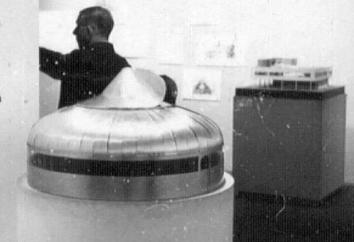Everything is Design
I was in the third-year design class at SIU in 1964-5. We studied systems theory and cybernetics with Bill Perk, designed machines to lift and transport bricks in Davis Pratt’s class, and learned graphic design from Harold Grosowsky and Herb Roan. The highlight of the year, though, was a two-week class taught by Buckminster Fuller.Buckminster Fuller!
Bucky had been on the cover of Time Magazine the year before. Bucky was the reason I was in design at SIU. The SIU Press had just published two of his books, and a third had been published in London. I’d recently seen Bucky’s Dymaxion house and oct-tet truss structure in a show at the Museum of Modern Art in New York City. Bucky was going to teach our class starting in March. Of course we had to get ready. This would be a very special class so we took the first two months of the winter term to prepare for the great event. We wanted the perfect learning environment for our time with Bucky so we did a makeover on our old World War Two barracks classroom.Designing the Environment
First, we build three new walls of Homasote. They were arranged to create a triangular room with the sides bowed out. Inside the triangular room we built a triangular conference table with an open center. Each side of the table accomodated 6 to 8 director chairs. Provisions were made for cameras to shoot through openings in the new walls and chalkboards, screens, and projectors were installed. We set up microphones and a tape recorder to capture every word. Once the construction was finished we painted the walls white and the special triagular table a bright gloss yellow. The day before Bucky’s arrival we did a final cleanup; we put our tools back in the wood dome; swept the classroom floor; cleaned all the windows; stashed paint trays, brushes and roller in the old shower at the back of the bathroom; and equipped ourselves with new notebooks, pencils, and plenty of 35 mm film.Buckminster Fuller, Teacher
On Monday morning March 1, 1965, our regular teachers escorted Buckminster Fuller into our bright new triangular classroom. We were in our seats around the bright yellow table, pencils sharp, notebooks open, with brains primed to absorb some knowledge. After introductions, we showed Bucky the features of the triangular classroom: where the chalk was and how to use the overhead. Bucky took off his dress wool overcoat and put it in the back room, found his stool at the front of the class and was about to start. He was probably dressed in one of his usual outfits; a white shirt, plain dark tie, dress shoes and either a nautical blue blazer with gray slacks or a camel color jacket with dark blue slacks. The first thing Bucky said that day was, “where’s the bathroom?” As he excused himself he explained that he often talks nonstop for three or four hours and that he didn’t like interruptions. Our anticipation and anxiety were reaching cosmic proportions. What did he think of our special learning environment? What were we going to learn? Would we build a dome? Bucky returned to the classroom after a long five minutes, sat on the drafting stool, put his hands together, bowed his head, and started thinking. After a 30 second silence—it seemed like an hour—he spoke. The lecture of a lifetime was underway.A Bucky Lecture
Bucky asked us to think about the cosmos and what we should be doing in it. He segued from “the tantalizingly almost realizable,” to some recent thoughts on astronomy and philosophical articulation that Fred Hoyle had written in the Saturday Review, a magazine of the times. Bucky explained how, “every local system loses energy through entropy but that nothing is really lost because of the law of conservation of mass and energy. Since mass is just very high frequency energy,” he said, “we could view radiation as disassociative while collection is associative.” “We have always thought of the Universe as a play that we watched. Now we are a part of it. So, the big question we needed to answer,” Bucky said, is “what should man be doing here in universe.” Bucky quoted Norbert Weiner’s answer to that question, “man is the most important anti-entropic functioner in the universe,” and then he added that Weiner came up with that, “about the same time that I
Design at Southern Illinois University



Bucky Exhibit at Museum of Modern Art, NYC





















